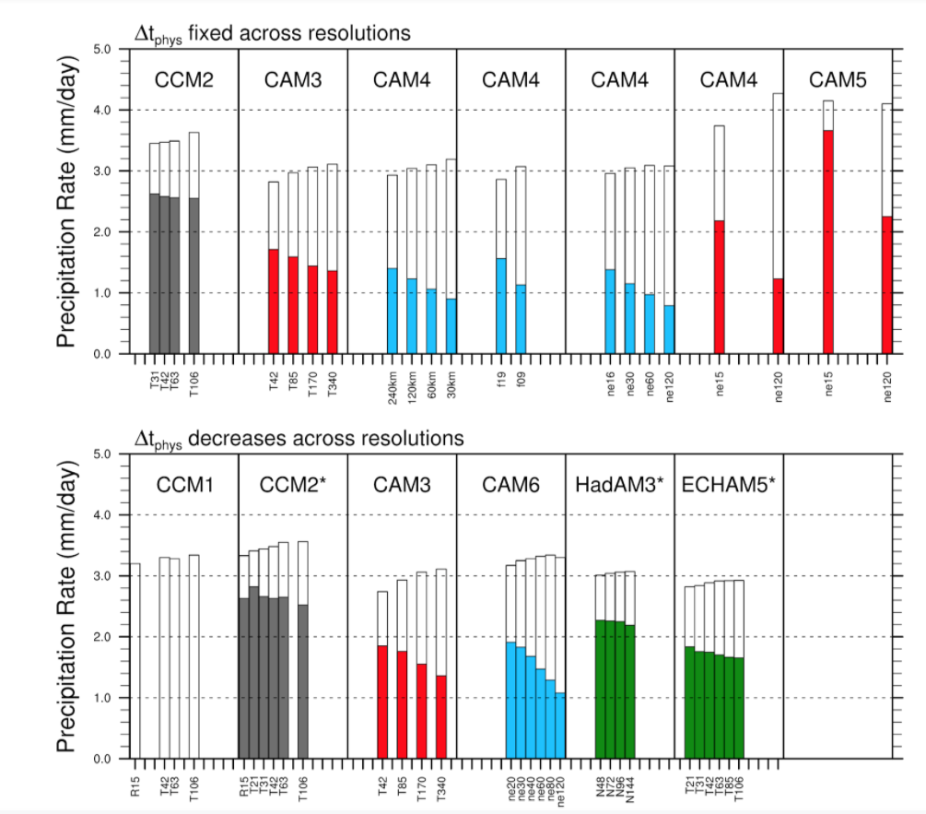Horizontal resolution
Exploring the benefits of increased horizontal resolution both globally and in regionally-refined configurations. Simulations with horizontal resolution of ~25km and finer are capable of explicitly simulating important mesoscale phenomena such as tropical cyclones. Targeted regionally-refined grids have been developed to study hydrological and cryospheric processes in key regions including the Continental United States (CONUS), South America including the Andean Cordillera, and Greenland.
Advances in high‐performance computing make it possible to run CAM over an increasingly wider range of grid resolutions, using either globally uniform or variable‐resolution grids. Simulations with horizontal resolution of ~25km and finer are capable of explicitly simulating important mesoscale phenomena such as tropical cyclones (e.g., Zarzycki et al. 2014). Targeted regionally-refined grids have been developed to study hydrological and cryospheric processes in key regions including the Continental United States (CONUS) and South America’s Andean Cordillera.
The usefulness of variable-resolution grids for cryospheric problems has fostered a collaboration between the Atmosphere Model Working Group and the Land Ice Working Group. In Greenland, regional refinement over the big ice sheet has shown to relieve longstanding biases in the simulated surface mass balance (van Kampenhout et al. 2019), and is being leveraged to project future sea level rise. The successful Greenland results have inspired a similar project targeting the meteorology and climate of the Antarctic ice sheet. And lastly, a high mountain Asia grid has been developed to simulate the mass balance of mountain glaciers in a region casually referred to as Earth’s third pole.
It is important to understand resolution sensitivity in order to inform the development of scale-aware physics. Resolution sensitivity in CAM is fairly well understood and is summarized in this excerpt from:
Herrington, AR, Reed, KA. On resolution sensitivity in the Community Atmosphere Model. Q J R Meteorol Soc. 2020; 1– 19. https://doi.org/10.1002/qj.3873
While increased resolution is an exciting opportunity to resolve atmospheric processes and scales in a global model and in unprecedented detail, in practice this grid flexibility is incompatible with the non‐ or weakly converging solutions with increasing horizontal resolution that have long characterized AGCMs. In the the Community Atmosphere Model (CAM), there are robust sensitivities to horizontal resolution that have persisted since the model was first introduced over thirty years ago (Figure 4); the atmosphere progressively dries and becomes less cloudy with resolution, and parameterized deep convective precipitation decreases at the expense of stratiform precipitation. This study documents a convergence experiment using CAM, version 6, and argues that a unifying cause, the sensitivity of resolved dynamical modes to native grid resolution, feeds back into other model components and explains these robust sensitivities to resolution. The increasing magnitudes of resolved vertical velocities with resolution are shown to fit an analytic scaling derived for the equations of motion at hydrostatic scales. This trend in vertical velocities results in an increase in resolved upward moisture fluxes at cloud base, balanced by an increase in stratiform precipitation rates with resolution. Compensating, greater magnitude subsiding motion with resolution has previously been shown to dry out the atmosphere and reduce cloud cover. Here, it is shown that both the increase in condensational heating from stratiform cloud formation and greater subsidence drying contribute to an increase in atmospheric stability with resolution, reducing the activity of parameterized convection. The impact of changing the vertical velocity field with native grid resolution cannot be ignored in any effort to recover convergent solutions in AGCMs, and, in particular, the development of scale‐aware physical parametrizations.

Figure: Bar-graph of the convective (solid) and stratiform (white) climatological precipitation rates in prior CAM/CCM convergence studies. Each window contains a single convergence experiment, with identical x-axis; the approximate grid resolution. Colors indicate the model configuration; January ensemble (black), aqua-planet configurations with SST profiles QOBS (blue) and CNTL (red) and annual means from an AMIP configuration (green). The asterisk (*) indicates that parameters are modified with resolution to reduce the dependence of cloud fraction and top-of-atmosphere radiative balance on resolution